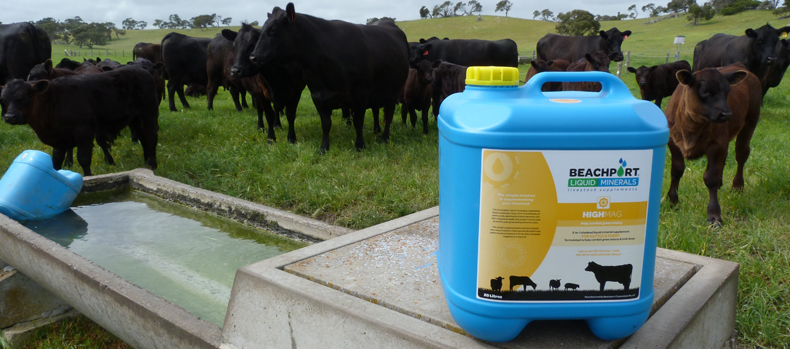Grass Tetany – Prevention is key

Don’t let Grass Tetany be a sudden shock to your herd this winter, Beachport can help!
From the break of the season, early winter feed and lush rapid growing feed can cause more problems than over the tougher dry months when we’re supplementary feeding livestock. Grass Tetany can be a problem overnight and unfortunately dead stock is usually the first sign there’s an issue.
Grass Tetany or hypomagnesaemia occurs when the Magnesium concentration in cerebrospinal fluid falls below a critical level, followed by a drop in serum Magnesium concentration. Simply, there’s an imbalance of intake and output of Magnesium causing a deficiency. Nonetheless, Grass Tetany can be a complex disorder and there are several predisposing factors making your animals susceptible.
Predisposing factors causing Grass Tetany
Early winter and spring feed often lack carbohydrates, fibre and Magnesium (Mg) creating a shortfall meeting the animal’s nutritional requirements. The unbalanced green feed contains high levels of potassium and non-protein nitrogen that reduces the absorption of Mg in the rumen. It’s important to avoid supplements high in salt and potassium because it further restricts the animal’s abilities to absorb Mg.
Critical times of production such as pregnancy, parturition and lactation further exacerbate your Grass Tetany risk due to elevated requirements of Mg for milk production, calcium mobilisation, energy metabolism and muscle function. Better milkers that are generally older animals with a higher body condition will be at greater risk.
Sudden stressors such as cold weather, frosts, acidosis and significant feed changes where poor transition caused other health issues like scouring, lameness or bloat can further increase your Grass Tetany risk.
Signs & Symptoms of Grass Tetany
Unfortunately, the first sign of grass tetany is usually sudden death of stock following a stress event. If noticed early subclinical symptoms of Grass Tetany include aggression, muscle tremors, staggers, increased difficulty with birthing and animals looking agitated.
Sub-clinically affected animals may not die, though there are production losses to consider when animals suffer from a Mg deficiency. Mg is essential for muscle function, the most significant muscles include the heart, uterus and rumen. Consequently, if these are not working efficiently it can lead to reduced appetite, poor feed conversion, heart failure and increased birthing difficulties. Mg plays a significant role in Calcium (Ca) mobilisation from bones, predisposing animals to Hypocalcaemia or Milk Fever. Inadequate levels of Mg and Ca in the animal reduces milk production and negatively affects progeny survival and growth rates.
How to prevent Grass Tetany
A prevention plan is vital to combat Grass Tetany, adequate feeding strategies coupled with Yellow Cap is a recipe for success. Managing stock’s transition onto green feed is crucial to reducing your grass tetany risk. Providing cereal based fibre and Beachport’s Yellow Cap 7-5 days prior to going onto green feed aids in elevating their blood levels of Mg before encountering the green feed challenge. By providing fibre in the days leading up to a feed change, it reduces the risk of stock entering a new paddock hungry and gorging on green feed. If animals are already grazing green feed, provide cereal based fibre and Yellow Cap during high-risk periods such as cold weather and frosts.
It is important not to stress stock if they are displaying subclinical signs of Grass Tetany in the paddock, do not muster and be sure to provide adequate fibre and Mg supplementation in a stress-free manner.
Yellow Cap is uniquely designed containing amino acids and fulvic acid to improve Mg absorption into the blood stream to help prevent Grass Tetany. Yellow Cap is 20% higher in Mg than our other products and has been chelated to enhance the absorption of Mg and other key trace elements. We recommend using our low-stress dispensing system to provide stock with Yellow Cap every 3 weeks over high-risk periods.
Click the links below for further information:
– Yellow Cap
– Find your nearest stockist
